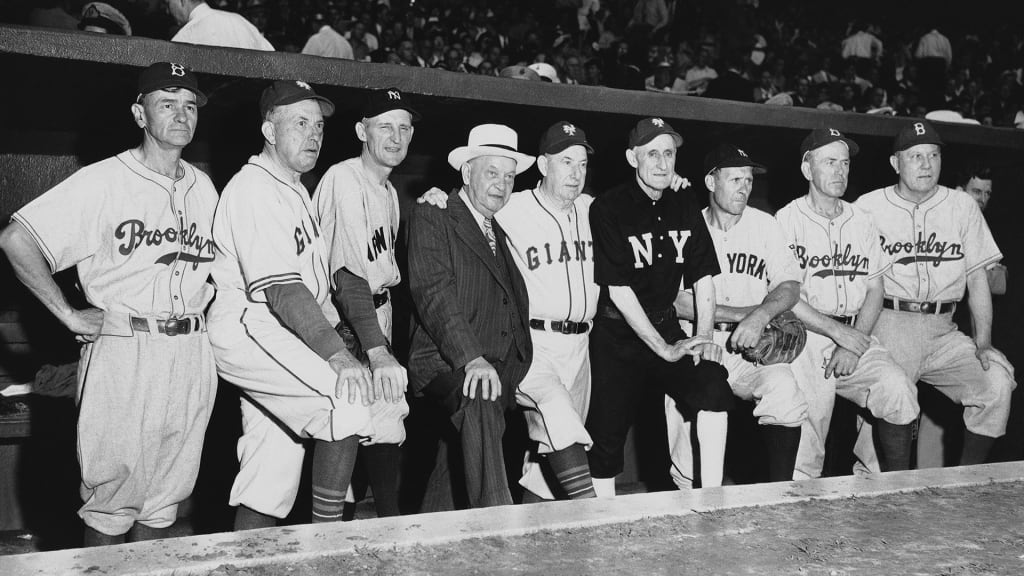Three-team game celebrates 75th anniversary

NEW YORK -- The vicissitudes of the World War II era left us some of the most colorful stories in the history of our national pastime. Among the most chronicled are the exploits of the All-American Girls Professional Baseball League and the marvel of Pete Gray, who patrolled the outfield for the St. Louis Browns despite having only one arm. Other quirks from that period include the fact that from 1943-45, several Major League teams held Spring Training in cold-weather locales like New Jersey and Ohio as part of a league-wide effort to conserve fuel by cutting back on travel.
And, there's the spectacle that took place in New York City 75 years ago Wednesday: A single game featuring not two teams, but three.
A mere 20 days after D-Day, as the fate of the free world hung in the balance, the New York Yankees, New York Giants and Brooklyn Dodgers starred in the unusual exhibition contest, which was held at the Polo Grounds to raise funds for the war effort.
With little to gain beyond bragging rights, the three teams faced off round-robin style for nine innings. Each team batted and fielded a total of six times, three times against each of its two opponents; no team saw action in more than two consecutive innings. (Organizers had to enlist the help of a Columbia University math professor to come up with the format.)
Except for the 500 wounded servicemen who were transported to the Polo Grounds from local hospitals, most of the 50,000 people who attended the “Tri-Cornered Game” gained admission by purchasing war bonds ranging in value from $25 to $1000.
But patrons didn’t see Joe DiMaggio in the outfield or Pee Wee Reese or Phil Rizzuto at short or Johnny Mize at first. All four were among the many Major League stars whose baseball careers were interrupted by military stints during the war, leaving the sport to those deemed unfit for service.
Still, with depleted rosters made up largely of veterans whose best years were behind them and unproven rookies, baseball forged ahead. It did so with the blessing of President Franklin D. Roosevelt, who expressed a belief that the game would boost morale during a frightening and uncertain time.
“I honestly feel it would be best for the country to keep baseball going,” Roosevelt wrote to Commissioner Mountain Kenesaw Landis in 1942 in what has become known as the “Green Light Letter.” “There will be fewer people unemployed and everybody will work longer hours and harder than ever before. And that means that they ought to have a chance for recreation and for taking their minds off their work even more than before.”
But organized baseball also made tangible contributions to the war effort by participating in fundraising events like the “Tri-Cornered Game.”
The Giants were the home team for the bizarre contest on June 26, 1944, leaving the Dodgers and Yankees to share the visitors' dugout. That meant that two future Hall of Fame skippers, Joe McCarthy of the Yankees and Leo Durocher of the Dodgers, found themselves strategizing against each other from the same bench. (The Giants, too, were managed by a future Cooperstown inductee, Mel Ott, who was also their right fielder at the time.)
According to the New York Times summary of the action, Durocher's Dodgers struck first, plating a run in the first inning against Yankees pitcher Al Lyons on singles by Goody Rosen, Augie Galan and Dixie Walker. With Johnny Allen of the Giants on the mound, Brooklyn added two more runs in the second inning on a walk to Mickey Owen, a double by Ed Stanky and a single by Frenchy Bordagaray.
No runner crossed the plate again until the eighth inning, when the Dodgers tacked on another pair of runs on a single by Luis Olmo, a triple by Jack Bolling and a sacrifice fly by Stanky, all against Giants pitcher Frank Seward.
The Yankees scored the only non-Dodgers run of the night in the ninth, thanks to a pair of fielding errors by Giants shortstop Buddy Kerr. By then, the Dodgers had left the field to get ready for a trip to Chicago, where they had a doubleheader against the Cubs on June 28.
After two hours and five minutes -- a swift game by modern standards -- the final score was Dodgers 5, Yankees 1, Giants 0. In what might be most shocking to a present-day baseball fan, none of the three teams managed to clear the fence that night.
The "Tri-Cornered Game" was ultimately a resounding success: Including a $50 million donation from the city of New York, it generated a whopping $56 million for the war effort.